There. I said it. It just does not work. OK, it works sometimes1. But it does not work in tight building enclosures and certainly not in new houses, apartments, townhouses and row houses. Basically in nothing new that we are building. Because it sucks – literally. I know we were here before (“BSI-069: Unintended Consequences Suck”, June 2013) but we have to come back and deal with it again. Why? As amazing as it seems, things have gotten worse and are going to get worse. But the good news is as they become intolerably bad we will end up finally dealing with them. Not quite there yet, but almost.
This next part should be obvious – but is apparently not to some people and quite acceptable to others. Exhaust-only ventilation leads to depressurization in houses, townhouses and row houses that are constructed to meet the 2015 International Residential Code and significant depressurization in apartment construction constructed to meet the 2015 International Building Code. In single family detached houses this leads to contaminants being pulled from attached garages – especially houses with bedrooms over garages. Contaminants are also pulled from under slabs – if radon was valuable we would mine it this way – and what better way to bring soil gas, herbicides and pesticides into a home?
In row houses and town houses exhaust-only ventilation leads to air being pulled from neighboring units as well as from attached garages and from under slabs. In apartments exhaust-only ventilation leads to air being pulled from neighboring units and corridors.
In apartment construction the corridor issue is a smoke and fire issue. You would think this might be something we ought to care about? Well we do. In a serious way. But from a “tightness” perspective not from a pressure perspective. We are getting good at the compartmentalization part – especially because we now test for it. But the compartmentalization makes the pressure issue way worse when we use exhaust only-ventilation.
Why not supply ventilation? Supply-only ventilation works in detached single family houses but not in apartments and townhouses and row houses as it drives air into neighboring units and we have the associated odor and contaminant transfer issue. You can’t ever make them “tight-enough” to prevent this – there are practical limits to compartmentalization.
Kinda leaves us with only one option that works in everything everywhere – balanced ventilation. Notice the words “everything” and “everywhere”…. But the Model Codes don’t encourage it and ASHRAE Standard 62.2 and RESNET actively discriminate against it2. That is insane. We are penalizing better systems when we incentivize poor systems and don’t encourage good systems. This is what I mean by things getting worse. We are incentivizing worse. We are discriminating against good. Note the word “insane”.
Are we done yet? Nope. How do you deal with exhaust vented kitchen range hoods? How about vented clothes dryers? The only viable options are interlocked powered make-up air3 for both or not using a vented clothes drier and going to condensing dryers. Or venting the apartment unit or house through the kitchen range hood and providing ducted supply air directly to the apartment unit or house. Good idea in compartmentalized buildings and low rise but not in tall buildings using central systems.
Not in tall apartment buildings? Huh? Yes, we have done this for years in tall apartment buildings. But there are two fundamental problems with large roof top exhaust systems pulling from every unit interlocked with large roof top supply systems ducted to every unit.
First, the approach tends to over-ventilate the entire building because the systems run all the time and units get ventilated regardless of whether they are occupied or not. Second, fighting the stack effect is not a trivial matter. Most units with central roof top exhaust and supply end up being over-ventilated or under-ventilated – by large margins. And all this is exacerbated by failure to compartmentalize units, corridors, elevators, utility shafts and stairwells. Yes, yes we were there before (“BSI-075: How Buildings Stack Up”, February 2014).
We need to compartmentalize (Figure 1 and Figure 2) and we need have individual distributed balanced ventilation systems in apartment buildings and row houses and town houses (Figure 3). And as I mentioned we are getting the compartmentalization figured out. And we are certainly getting new houses, town houses and row houses tight. Why? Again, I mention for emphasis, we are testing them. These things are code requirements and we are testing for them and meeting them.
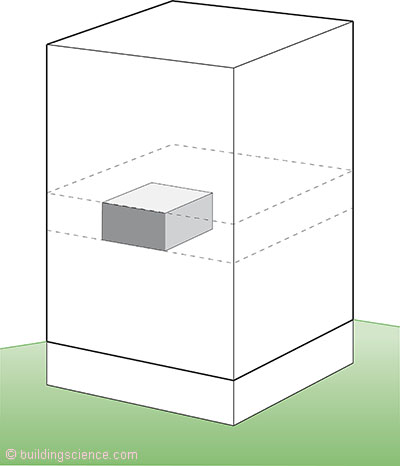
Figure 1: Compartmentalization – This is what it means. No air from the top of the “cube” or the bottom of the “cube” or the sides of the “cube”. And we go out of our way to make the front of the cube “tight” as well. When you “suck” where does the air come from?

Figure 2: Row House or Town House – This is what the Model Codes ask for and are getting. No air from neighboring units and “tight” construction. When you “suck” where does the air come from?

Figure 3: Balanced Ventilation in an Apartment Building – Out with the bad and in with the good in a balanced controlled powered manner. Individual distributed balanced ventilation systems.
So, distributed balanced ventilation systems work in everything everywhere. But, and a big but, in small units and small houses we are going to need supplemental dehumidification. Aw man…yes, pretty much everywhere south of the Mason-Dixon Line and east of Interstate 35 in Texas. In hot-humid climates and mixed-humid climates part load humidity cannot be controlled without supplemental dehumidification. Relax. Everyone relax. This can be accomplished with stand-alone dehumidifiers. We have the technology. And yes, we were here before. What has changed is that we now have better and more options available. We have the technology (Figure 4). Small wall-mounted fit-in-the-stud space dehumidifiers. A nice improvement over the older technology (Figure 5 and Photograph 1).
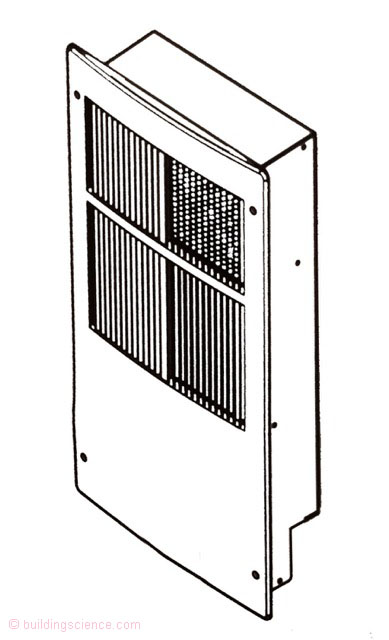
Figure 4: Supplemental Dehumidification - Relax. Everyone relax. This can be accomplished with stand-alone dehumidifiers. Small wall mounted fit-in-the-stud space dehumidifiers. A nice improvement over the older technology.

Figure 5: Old Dehumidification Technology – Cheap dehumidifier in a return closet. Works, but we can do better.
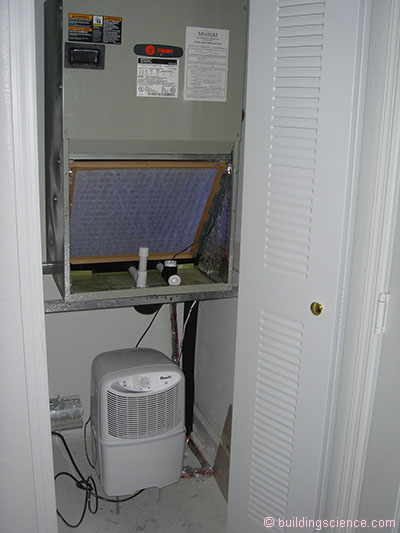
Photograph 1: Dehumidifier In Return Closet – Works but we can do better.
Don’t forget the vented clothes dryers. They extract 200 cfm or more from units, houses, row houses and town houses. Best solution, don’t use them. Use condensing clothes dryers. The big change for condensing clothes dryers in the last few years is that manufacturers have figured out there actually is a market for them. Yes, we have had condensing clothes dryers for quite a long time – but not large ones that actually dry clothes before you finish reading “War and Peace”4. We got large “SUV” sized ones “turbo-charged” as befits us non-Europeans.
What about kitchen range hoods? Yes, I know we were here before (“BSI-070: Deal with Manure & Then Don’t Suck”, June 2014). But things are getting easier. We are getting better capture efficiency with better hood design and that means we can get away with lower exhaust flows (Photograph 2 and Photograph 3). And we are on the verge of getting make-up air systems that are premanufactured and designed for residential applications. Right now you have to be a real engineer and design your own. You have to duct the make-up air under the cook top and decide how to precondition the or not.5
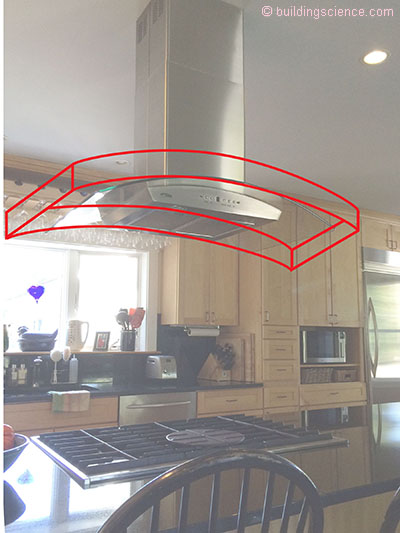
Photograph 2: Kitchen Range Hoods - We are getting better capture efficiency with better hood design and that means we can get away with lower exhaust flows.
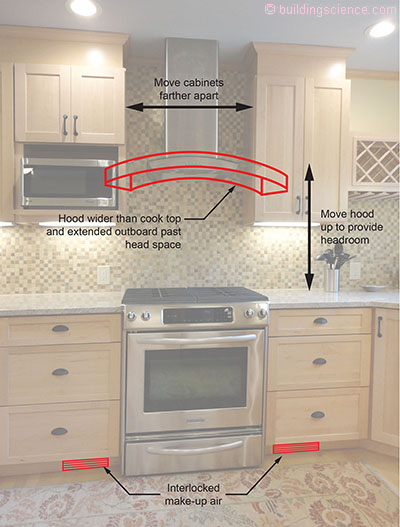
Photograph 3: Need Some Space Here – Need a bigger hood, a deeper hood and interlocked make-up air.
Can you get away with really small kitchen range hood exhaust that has high capture efficiency in a tight enclosure? Yes, maybe, I think, not sure. Less than 100 cfm of exhaust intermittently? Have not done the work. No one really has. Someone should. Note that intermittently means not all the time.
So what should these balanced ventilation systems look like? I’ve been playing with a couple that follow.
Each system is balanced and has provision for powered interlocked make-up air for vented kitchen range hoods. Each system is designed to operate in single family detached houses, town houses, row houses or compartmentalized multifamily units and with distributed heating and cooling systems or central systems where only hot water or chilled water or refrigerant is distributed, not air.
The first system (Figure 6) uses an outside air duct is connected to the return side of the air handler and the air handler operates continuously. The air handler is interlocked with a continuous bathroom exhaust fan. The rate at which outside air is brought in through the outside air duct is matched by the exhaust rate of the bathroom exhaust. For example, if 45 cfm is supplied via the outside air duct then the bathroom fan exhausts continuously at a rate of 45 cfm. In apartment units with only one bathroom this is pretty easy. Single exhaust fan is used. If two or three bathrooms are in the unit or we are dealing with a single detached house or town house or row house then the exhaust rate is split between the bathrooms. A single exhaust fan is used with an exhaust grille in each bathroom. There are controls available to make all this work. The individual fans operate at a low speed for general ventilation and intermittently at a higher rate when the bathroom is in use. A vented kitchen range hood is ducted separately to the exterior and is interlocked with a separate make-up air fan.
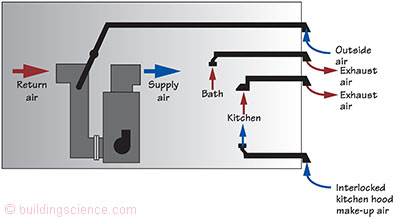
Figure 6: First System - Outside air duct is connected to the return side of the air handler and the air handler operates continuously. The air handler is interlocked with a continuous bathroom exhaust fan. A vented kitchen range hood is ducted separately to the exterior and is interlocked with a separate make-up air fan.
The second system adds supplemental dehumidification provided by a dehumidifier (Figure 7).

Figure 7: Second System – Supplemental dehumidification using a dehumidifier.
The third system (Figure 8) uses a fully-ducted heat recovery ventilator (HRV) or a fully-ducted energy recovery ventilator (ERV) providing balanced ventilation independent of the forced air conditioning system. The HRV/ERV extracts air from the bathroom(s) and supplies air to the bedroom(s). The rates modulate based on switches in each bathroom uping the rate intermittently when the bathrooms are in use. A vented kitchen range hood is ducted separately to the exterior and is interlocked with a separate make-up air fan. It is a bad idea to vent the kitchen range hood through an HRV or ERV. Did I mention that this is a bad idea?
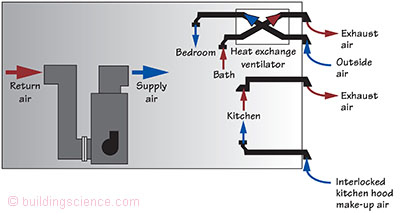
Figure 8: Third System - Fully-ducted heat recovery ventilator (HRV) or a fully-ducted energy recovery ventilator (ERV) providing balanced ventilation independent of the forced air conditioning system. The HRV/ERV extracts air from the bathroom(s) and supplies air to the bedroom(s). The rates modulate based on switches in each bathroom uping the rate intermittently when the bathrooms are in use. A vented kitchen range hood is ducted separately to the exterior and is interlocked with a separate make-up air fan. It is a bad idea to vent the kitchen range hood through an HRV or ERV. Did I mention that this is a bad idea?
The fourth system also adds supplemental dehumidification with a dehumidifier (Figure 9).
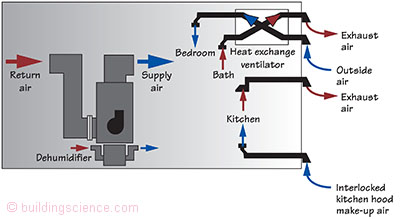
Figure 9 – Fourth System - Supplemental dehumidification added to the third system.
The fifth system (Figure 10) works in apartment units or exceptionally efficient houses. A fully-ducted heat recovery ventilator (HRV) or a fully-ducted energy recovery ventilator (ERV) provides balanced ventilation independent of the space conditioning system. That space conditioning could be a packaged terminal heat pump (PTHP) as shown, or in the case of exceptionally efficient houses, mini-split or multi-split heads. The HRV/ERV extracts air from the bathroom(s) and supplies air to the bedroom(s). As in the previous cases a vented kitchen range hood is ducted separately to the exterior and is interlocked with a separate make-up air fan. Note, that with exceptionally efficient houses, even when using more than one head some mixing is necessary to provide thermal comfort.
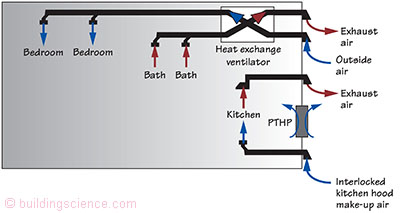
Figure 10: Fifth System – System for apartment units or exceptionally efficient houses. A fully-ducted heat recovery ventilator (HRV) or a fully-ducted energy recovery ventilator (ERV) provides balanced ventilation independent of the packaged terminal heat pump (PTHP) conditioning system or in the case of exceptionally efficient houses independent of the heads of multi split systems. The HRV/ERV extracts air from the bathroom(s) and supplies air to the bedroom(s). As in the previous cases a vented kitchen range hood is ducted separately to the exterior and is interlocked with a separate make-up air fan. Note, that with exceptionally efficient houses, even when using more than one head some mixing is necessary to provide thermal comfort.
The sixth system adds supplemental dehumidification in the usual way (Figure 11).
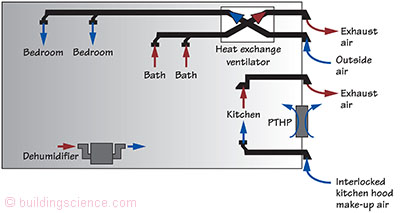
Figure 11 – Sixth System - Adding supplemental dehumidification in the usual way.
The seventh system (Figure 12) is used in locations where air conditioning is not used such as the Pacific Northwest. A fully-ducted heat recovery ventilator (HRV) or a fully-ducted energy recovery ventilator (ERV) provides balanced ventilation. Heating is provided by a radiant heating system. The HRV/ERV extracts air from the bathroom(s) and supplies air to the bedroom(s). Again, as with all the previous systems, a vented kitchen range hood is ducted separately to the exterior and is interlocked with a separate make-up air fan.

Figure 12 – Seventh System - Used in locations where air conditioning is not used such as the Pacific Northwest. A fully-ducted heat recovery ventilator (HRV) or a fully-ducted energy recovery ventilator (ERV) provides balanced ventilation. Heating is provided by a radiant heating system. The HRV/ERV extracts air from the bathroom(s) and supplies air to the bedroom(s). Again, as with all the previous systems, a vented kitchen range hood is ducted separately to the exterior and is interlocked with a separate make-up air fan.
Yes, architects, I know, I know. Lots of penetrations in the walls (Photograph 4). Get over it. You want energy efficiency? You want a controlled indoor environment? You want to build tight and ventilate right? You better get used to living with the holes. Putting the stuff on the roof or at the bottom of the building does not work. Might work in houses and row houses and town houses but not in apartments.
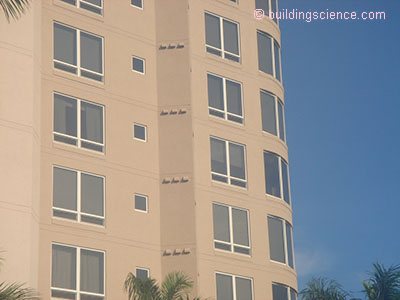
Photograph 4: Lots of Penetrations - You want energy efficiency? You want a controlled indoor environment? You want to build tight and ventilate right? You better get used to living with the holes. Putting the stuff on the roof or at the bottom of the building does not work. Might work in houses and row houses and town houses but not in apartments.
Are we done yet? Nope. Let me talk about insane and insulting to ones intelligence. There are currently no provisions in any US codes or standards that recognize the benefits of balanced systems with mixing and distribution. Balanced systems with mixing and distribution do much more with less air than exhaust systems without mixing and distribution. There should be some reward and punishment here.
Actually, there is. We reward the exhaust systems without mixing and distribution and punish the balanced systems with mixing and distribution because we treat them the same. It is pretty clear that ASHRAE is incapabable of fixing this based on the current antics of the ASHRAE Standard 62.2 Committee. But I have hope for RESNET and both the IRC and the IBC. Stay tuned. It is going to get worse before it gets better. But better will happen. Just not easily and not without pain.
Footnotes:
Leaky single family detached houses with small exhaust flows with undersized air conditioners and poor solar control with black shingles and poorly insulated ducts located in vented attics – the types of houses that we encourage people to build……Exhaust-only ventilation no longer works in new single family detached because we now codify “tight” and test for it.
Following ASHRAE Standard 62.2 results in higher air change when a balanced ventilation system is compared to an exhaust-only ventilation system. It gets worse. RESNET procedures result in rating points hits when balanced systems are used as compared to exhaust only systems because RESNET references ASHRAE Standard 62.2. Builders and raters are not stupid…both are “gaming the ratings system” and exhaust ventilation becomes the obvious choice. RESNET stands for “Residential Energy Services Network” and is responsible for the Home Energy Rating System (HERS) index.
Don’t talk to me about recirculating range hoods…those are like toilet bowls that never flush swirling stuff round and round…..
Author: Leo Tolstoy, first published 1869, paperback 1,440 pages.
Just putting a hole in the wall does not work – especially in the hot humid south – every a/c supply grill between the hole and the exhaust hood is going to sweat as the make-up air finds its way to the hood. And you have to figure the control thing out… Most of the time I do not precondition – or if I do I just mix it with air already in the space to temper it.
Reference:
CMHC (2005). “Assessment of Suite Compartmentalization and Depressurization in New High-Rise Residential Buildings”, Research Highlight, Technical Series 05-112, October 2005.
Finch, G., J. Straube and C. Genge (2009). “ Air Leakage Within Multi-Unit Residential Buildings: Testing and Implications for Building Performance”, 12th Canadian Conference on Building Science and Technology, Montreal, PQ, October 2009.
Handegord, G.O., (2001). “A New Approach to Ventilation of High Rise Apartments” Proceedings of the Eighth Conference on Building Science and Technology, Ontario Building Envelope Council, Toronto, Ontario, February, 2001.
Lstiburek, J (September 2015). “BA-1507: Ventilation Guidance for Residential High Performance New Construction – Multifamily” Building Science Corporation, http://buildingscience.com/documents/building-america-reports/ba-1507-me.... September 17, 2015.
Ricketts, L., J. Straube (2014). “ A Field Study of Airflow in Mid to High-Rise Multi-Unit Residential Buildings”, 14th Canadian Conference on Building Science and Technology, Toronto, October 2014
Rudd, Armin (August 2013). "BA-1310: Supplemental Dehumidification in Warm-Humid Climates". Building Science Corporation, http://www.buildingscience.com/documents/bareports/ba-1310-supplemental-.... October 22, 2013.
